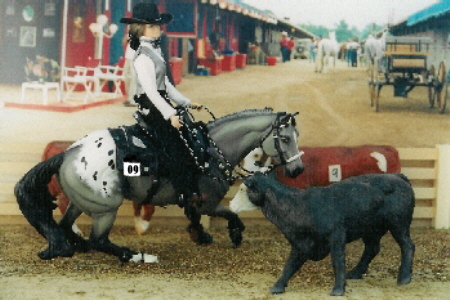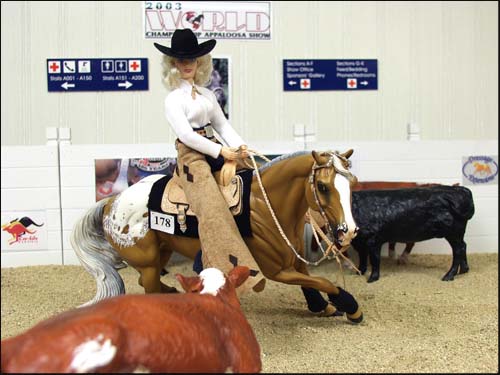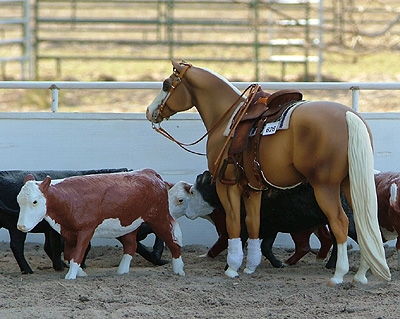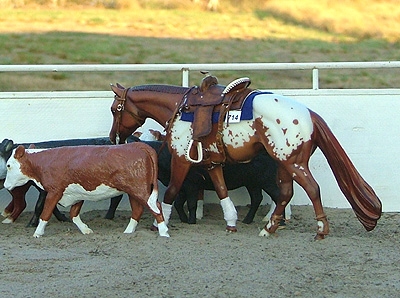IMEHA (International Model Equine Hobbyists Association) was an online photo showing site that existing until 2018. Included on the site were these guidebooks for judging and showing model horses in Performance classes. MEPSA has obtained permission to share the info contained in the guides.
Scoring :: Point Deducts :: Tack :: Rider :: Reins :: Set-Up Options :: Photo Examples
A class in which a horse and rider enter a herd usually on the back wall of the arena and separates one from the group. The horse keeps the selected cow from returning to the herd. The horse is judged on skill, agility and ability and is given 90 seconds to work two cattle. There is an option to a third cow if time allows. There are two herd holders to the right and left of the area were the rider works the entry (they keep the herd on the rail) and two turn back riders on the opposite side of the rider working the cow. Their job is to keep the chosen cow interested in returning to the herd.
Watch for the following:
Don’t put a loping horse model inside the herd. Horses are supposed to select the cow quietly.
Don’t use the fence to control the cow that’s a strong penalty.
A horse slightly ahead of the cow is not in control and risks losing the cow. Judges should “plot” the next moves of the horse & cow as the cow could escape the horse and return to the herd.
Horses eye should be in a direct line with the eye of the cow as the horse must watch the cow or he could lose it.
Bovines used in cutting are usually cows or steers and not calves. If calves are used there should be a penalty.
Goats and other animal can used in cutting or stock work classes in training conditions but this should be specified with a comment line.
You Score Cutting on the following basis:
1) Each horse is required to enter the herd sufficiently deep enough to show his ability to make a cut. One such deep cut will satisfy this rule. Failure to satisfy this requirement will result in a three (3) point penalty. A horse will be given credit for his ability to enter the herd quietly with very little disturbance to the herd or to the one brought out.
2) When an animal is cut from the herd, it is more desirable that it be taken toward the center of the arena, and credit will be rewarded for same. Additional credit will be given the horse which drives his stock sufficient distance from the herd to assure that the herd will not be disturbed by his work, thereby showing his ability to drive a cow.
3) Riding with a loose rein throughout a performance is a requirement and will be recognized.
4) Credit will be recognized for setting up a cow and controlling it in a working position as near the center of the arena as possible.
5) If the cutting horse or his rider creates disturbance at any time throughout his working period (2-1/2 minutes), he will be penalized:
a. Any noise directed by the contestant toward the cattle will be penalized one (1) point.
b. Each time a horse runs into the herd, scatters the herd while working or picks up cattle through fault of the horse, he will be penalized three (3) points. The entire cow must enter working area of horse.
6) A horse will be penalized three (3) points each time the back fence actually stops or turns the animal being worked within one step (three [3] feet) of the fence; the back fence to be agreed on and designated by the judge or judges before the contest starts; meaning the actual fence only, no imaginary line from point to point to be considered. If any of the contestants voice an objection before the contest starts, the judge or judges shall take a vote of the contestants, and a “back fence” acceptable to the majority shall be designated and used.
7) If a horse turns the wrong way with tail toward animal being worked, an automatic score of 60 points will be given.
8) While working, a horse will be penalized one (1) point each time the reins are used to control or direct (to rein) the horse, regardless of whether the reins are held high or low. A one (1) point penalty shall also be charged whenever a horse is visibly cued in any manner. If the reins are tight enough that the bits are bumped at any time, he shall be penalized one (1) point each time even though the hand of the rider does not move.
a. A horse must be released as soon as the desired animal is clear of the other cattle. Additional reining, cuing or positioning will result in a one (1) point penalty for each occurrence.
b. The rider shall hold the bridle reins in one hand. The exception is a hackamore or snaffle where two hands are on the rein. A three (3) point penalty shall be charged if the second hand touches the reins for any purpose except to straighten them.
c. Cueing behind the shoulder shall not be considered a visible cue. A three (3) point penalty shall be assessed each time a horse is cueed in the shoulder.
d. A toe, foot, or stirrup on the horse’s shoulder is considered a visible cue. A one (1) point penalty shall be charged for each occurrence.
9) If a horse lets an animal that he is working get back in the herd, he will be penalized five (5) points.
10) If a rider changes cattle after visibly committing to a specific cow, a five (5) point penalty will be assessed.
11) When a horse loses his working advantage, loses eye contact with cow, misses a cow, or is working out of position; he will be penalized (a) ½ point, (A) 1 point, or (F) 1 point.
12) Unnecessary roughness, such as a horse actually pawing, biting or kicking cattle, will be penalized three (3) points.
13) A contestant may quit an animal when it is obviously stopped, obviously turned away, or is obviously behind the turnback horses and the turnback horses are behind the time line. A penalty of three (3) points must be charged if the animal is quit under any other circumstances.
14) If a horse quits a cow, a penalty of five (5) points will be assessed.
15) If a horse clears the herd with two (2) or more cattle and fails to separate a single animal before quitting, a five (5) point penalty will be charged. There is no penalty if time expires.
16) Horses must be ridden with a bridle having a bit in the mouth or with a hackamore. All bridles on horses must have split reins. A bridle shall have no nose band or bosal and hackamores shall be of rope or braided rawhide with no metal parts. Braided rawhide balls across the horse’s nose are not permissible. A judge must be able to freely pass two fingers between the hackamore and muzzle completely around the horse’s nose. Choke ropes, tie downs, wire around the horse’s neck, nose, or brow band, tight nose band, quirt, bat or mechanical device giving the rider undue control over a horse will not be permitted in the arena where an NCHA approved or sponsored event is being held. Wire of any kind and on any part of the curb device is not permissible. Leather curb straps or curb chains must be at least 3/8 of an inch in width and must be attached to the bit by nylon string, nylon straps, or leather straps. Decorative knots, rawhide balls or tassels are not permitted on curb devices. Breast collar may be used, no portion of which may pass over the horse’s neck. Breast collars attached to the swell of the saddle on competing horses will be considered illegal. Chaps and spurs may be worn. A competing horse’s tail cannot be tied in any manner which would restrict movement of the tail. Any time a contestant is guilty of an infraction of this rule or any part therein, he shall be disqualified. Contestants must wear long sleeved shirts with collars and buttons or snaps completely down the shirt front. T-shirts and slipover knits are not permissible. Sweaters may be worn over an appropriate shirt. Long sleeves must be worn rolled down. For youth classes only, safety helmets are permissible in place of a western hat.
17) When a contestant is thrown from a horse or the horse falls to the ground, the run shall be terminated and no score (0) will be given.
18) Any rider who allows his horse to quit working or leave the working area before his allotted time is up will be disqualified for that goround with no score.
19) A contestant will be awarded a complete rework if in the judge or judges’ opinion 2-1/2 minutes time was not allotted for the work, or if excessive disturbances had been created by factors other than those caused by the contestants or their help and the judge or judges have stopped the time. Such factors would include gates coming open, fences falling down and objects entering or falling into the working portion of the arena, but would not apply to cattle scattering through wildness or normal arena activities. Any rework must take place within the group of cattle drawn by the contestant and must occur before a change of cattle is executed. At the contestant’s option, the rework may occur immediately or as the last work in that set of cattle. No rework shall be granted if the contestant involved has incurred a three (3) or five (5) point (major) penalty prior to a disturbance. After the cutter has completed his 2-1/2 minutes work, if in his/her opinion a situation has occurred of sufficient seriousness so as to warrant a rerun, he/she may immediately make a request for the same to the Contestant’s Representative or to the designated judge or judges who shall report this fact to show management before the next horse is called to work. Show management shall make such facts as are available known to the judge(s) and if the majority are in agreement that due cause did exist a rerun may be granted provided the original work was free of a three (3) or a five (5) point (major) infraction. If the clock has not started, a re-work will automatically be granted.
20) A judge marks from sixty (60) to eighty (80) points. One-half (1/2) points are permissible.
Extra Credit Should Be Given If:
(1) Split reins are used, the rein should fall on the same side as the rein hand.
(2) Any imagination in set up and design.
Points Should be Deducted If…
Penalties: 1 point off:
(a) (miss) losing working advantage (11)
(b) reined unless a hackamore or snaffle bit is used or visibly cued (8)
(c) noise directed to cattle (5a)
(d) toe, foot or stirrup on the shoulder (8d)
(e) hold on too long on a cut (8a)
(f) working out of position
Penalties: 3 points off:
(a) hot quit (13)
(b) cattle picked up or scattered (5b)
(c) second hand on reins unless a hackamore bosal or snaffle bit is used (8b)
(d) cue in shoulder (8c)
(e) pawing or biting cattle (12)
(f) failure to make a deep cut (1)
(g) back fence (6)
Penalties: 5 points off:
(a) horse quitting a cow (14)
(b) losing a cow (9)
(c) changing cattle after a specific commitment(10)
(d) 5 points—failure to separate a single animal after leaving the herd (15)
Penalties: 60 points off:
(a) if horse turns tail (7)
(b) if horse falls to ground (17)
Disqualification (score 0)—illegal equipment, or leaves working area before time expires
Give Credit For…
Rule 22) CREDIT:
A. for entering the herd quietly with very little disturbance to the herd or to the animal brought out (Rule 1).
B. for taking an animal toward the center of the arena (Rule 2).
C. for driving a cow a sufficient distance from the herd to assure that the herd will not be disturbed by the contestant’s work (Rule 2).
D. for riding with a loose rein throughout a performance (Rule 3).
E. for setting up a cow and holding it in a working position as near the center of the arena as possible (Rule 4).
F. Never losing eye contact with cow the horse is working. (Rule 11)
23) RUN CONTENT:
Herd Work—Driving a cow
Controlling the cow—Working in center of arena
Degree of Difficulty
Eye Appeal
Time Worked
Amount of Courage
Loose Reins
Horse Charging
Forced Off a Cow
Excessive Herdholder Help
Required Tack:
Western saddle of any style with split reins. But usually a saddle with a second cinch is used to ensure less stress on the horse’s loins and back. If a second cinch is used remember to use a rear-cinch connecting strap. Five and under horses show in a bosal or a snaffle bit. Romal reins for forbidden in cutting. Breast collars are often used. Only one hand on the rein unless the bridle is a snaffle or a hackamore bosal.
Optional but Strongly Suggested Tack:
Leg protection is necessary on all four legs and horses wearing it should be given credit over bare legged entries. A standard sliding, rundown or skid boot on the rear fetlocks and splint boots or bell boots on the front legs are optional appointments in the following classes: Team penning, cutting, working cow horse, reining, steer daubing, games and roping. The use of soft leg wraps will be permitted.
Prohibited Tack:
Tie downs, martingales, gag bits, nosebands, closed roping reins, crops or whips, mechanical hackamores, tapaderos, wire curbs or a chin strap under one-half inch wide are forbidden equipment. Romal reins were in style several years ago but have phased out. Split reins may not be knotted or attached to each other (stick wax is of course permitted in model horses).
Rider:
Attire is jeans, trousers or pants over western boots, long sleeved shirts, (vest, tie and jacket are also permitted) belt through loop, and western hat. Chaps are optional but strongly suggested. The doll rider’s posture must be addressed because if you can’t get it correctly then don’t use it. Doll must sit down in the saddle, the back should be straight. There should be a straight vertical line between the rider’s ear, the elbow and the heel. The knee and toe of the boot should also be in a straight line, knees and feet turned straight along the side of the horse and heel of boot pointed down. The rein arm upper arm should be tucked into the side of the rider, elbow is bent and the forearm parallel to the ground. The free arm is held free and straight down with palm flat and lightly touching the leg. You may place ONE finger between your split reins and there is no rule as to which one – though most riders place their index finger between. If using romal reins the romal hand is carried with hand holding romal at the length of which the romal is straight and not curved. Hand then rest quietly near or on the doll’s leg. Hackamore or snaffle reins the riders hands should be carried near the pommel and not further than four inches (to scale) out on either side of the saddle horn. Rein hand wrist(s) of either rein is turned slightly inward. The doll rider’s head should be looking straight forward as if rider is looking through the horse’s ears.
Rein Hand Holds:

Rein Pull:
Horses are shown on a reasonable loose rein. Extremes such as too tight or too loose should be penalized.



Set-Up Options:
Arena Fencing Required (Indoor or Outdoor Arena)
Types of Fencing Allowed:
- Painted or Natural
- Post and Rail
- Post and Plank
- Chain Link
- Solid Plyboard
- Plyboard with Top Rail
- Post with Drape Rope
- Stock Tube Pipe Rail
- Interior Arena Wall
Footing Required:
- Dirt
- Sand
- No grass base
- No rock base
Backboard or Natural Setting (Indoor or Outdoor)
Examples of Cutting:

Photo Credit:
Obvious Asset, shown as a grulla Appaloosa Mare. Photo taken by Cynthia Jameson. Note hackamore bosal in which reining the horse and use of two hands on the reins are permitted.

Photo Credit:
OJF Legally Blonde, shown as a palomino and blanket Appaloosa mare. Photo taken by Susan Hargrove.

Photo Credit:
Good Description of Standing Horse Cutting Entry
Boontown Diamonds shown as a Palomino Quarter Horse Mare, Mold is a CM Lady Phase. Comments: Boontown pauses for a second to let the cows shift around her before selecting the cow to cut. Shown by Veronica Geddie.

Photo Credit:
Walking Horse Cutting Entry
An Impressive Dip shown as a Sorrel Blanket Appaloosa Stallion. Mold is a Breyer Zippo Pine Bar. Comment Line reads: Dip walks quietly into the herd to cut out his chosen cow. Shown by Veronica Geddie.
